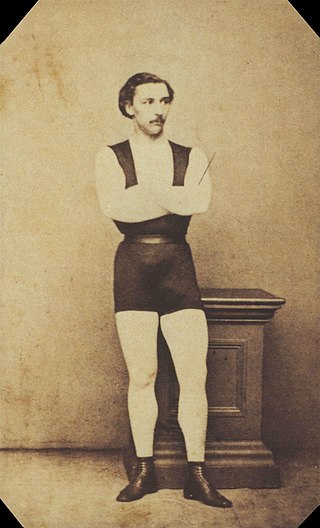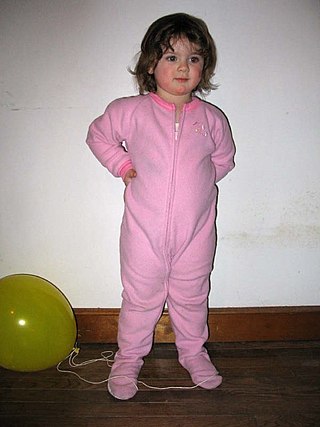
A leotard is a unisex skin-tight one-piece garment that covers the torso from the crotch to the shoulder. The garment was made famous by the French acrobatic performer Jules Léotard (1838–1870). There are sleeveless, short-sleeved, and long-sleeved leotards. A variation is the unitard, which also covers the legs.

A wetsuit is a garment worn to provide thermal protection while wet. It is usually made of foamed neoprene, and is worn by surfers, divers, windsurfers, canoeists, and others engaged in water sports and other activities in or on water. Its purpose is to provide thermal insulation and protection from abrasion, ultraviolet exposure, and stings from marine organisms. It also contributes extra buoyancy. The insulation properties of neoprene foam depend mainly on bubbles of gas enclosed within the material, which reduce its ability to conduct heat. The bubbles also give the wetsuit a low density, providing buoyancy in water.

A sweater or pullover, also called a jersey or jumper, is a piece of clothing, typically with long sleeves, made of knitted or crocheted material that covers the upper part of the body. When sleeveless, the garment is often called a slipover, tank top, or sweater vest.

A shirt is a cloth garment for the upper body.

A waistcoat or vest is a sleeveless upper-body garment. It is usually worn over a dress shirt and necktie and below a coat as a part of most men's formal wear. It is also sported as the third piece in the traditional three-piece male suit. Any given waistcoat can be simple or ornate, or for leisure or luxury. Historically, the waistcoat can be worn either in the place of, or underneath, a larger coat, dependent upon the weather, wearer, and setting.

A blouse is a loose-fitting upper garment that may be worn by workmen, peasants, artists, women, and children. It is typically gathered at the waist or hips so that it hangs loosely ("blouses") over the wearer's body. Today, the word most commonly refers to a girl's or woman's dress shirt, although there is considerable confusion between a true blouse and a women's shirt. It can also refer to a man's shirt if it is a loose-fitting style, though it rarely is. Traditionally, the term has been used to refer to a shirt which blouses out or has an unmistakably feminine appearance, although even many "standard" shirts today have a somewhat blousy fit, and the numbers of men wearing such shirts may match that of women wearing actual blouses.

A nightgown, nightie or nightdress is a loosely hanging item of nightwear, and is commonly worn by women and girls. A nightgown is made from cotton, silk, satin, or nylon and may be decorated with lace appliqués or embroidery at the bust and hem.

A jacket is a garment for the upper body, usually extending below the hips. A jacket typically has sleeves and fastens in the front or slightly on the side. A jacket is generally lighter, tighter-fitting, and less insulating than a coat, which is outerwear. Some jackets are fashionable, while others serve as protective clothing. Jackets without sleeves are vests.

A chemise or shift is a classic smock type of women's undergarment or dress. Historically, a chemise was a simple garment worn next to the skin to protect clothing from sweat and body oils, the precursor to the modern shirts commonly worn in Western nations.

A spaghetti strap is a very thin shoulder strap used to support clothing, while providing minimal shoulder straps over otherwise bare shoulders. It is commonly used in garments such as swimwear, camisoles, crop tops, brassieres, sundresses, cocktail dresses, and evening gowns, so-named for its resemblance to the thin pasta strings called spaghetti.

The blanket sleeper is a type of especially warm sleeper or footie pajama worn primarily during the winter in the United States and Canada. The garment is worn especially by young children.

A teddy, also called a camiknicker, is a garment which covers the torso and crotch in the one garment. It is a similar style of garment to a one-piece swimsuit or bodysuit, but is typically looser and sheerer. The garment is put on by stepping into the leg holes and pulling the garment up to cover the torso. It may cover the whole of the torso or partially and may also cover the arms. They may open at the crotch so that the wearer may use the bathroom without taking it completely off. As an undergarment, it combines the functions of a camisole and panties, and may be preferred to avoid a visible panty line. It is also found as lingerie.

Halterneck is a style of women's clothing strap that runs from the front of the garment around the back of the neck, generally leaving the upper back uncovered. The name comes from livestock halters. The word "halter" derives from the Germanic words meaning "that by which anything is held". Halter is part of the German word for bra, Büstenhalter.

A mandarin collar, standing collar, Nehru collar, band collar or choker collar is a short unfolded stand-up collar style on a shirt or jacket. The style derives its Western name from the mandarin bureaucrats in Qing-era China that employed it as part of their uniform.

Fashion in the period 1700–1750 in European and European-influenced countries is characterized by a widening silhouette for both men and women following the tall, narrow look of the 1680s and 90s. This era is defined as late Baroque/Rococo style. The new fashion trends introduced during this era had a greater impact on society, affecting not only royalty and aristocrats, but also middle and even lower classes. Clothing during this time can be characterized by soft pastels, light, airy, and asymmetrical designs, and playful styles. Wigs remained essential for men and women of substance, and were often white; natural hair was powdered to achieve the fashionable look. The costume of the eighteenth century, if lacking in the refinement and grace of earlier times, was distinctly quaint and picturesque.

Fashion in the years following World War II is characterized by the resurgence of haute couture after the austerity of the war years. Square shoulders and short skirts were replaced by the soft femininity of Christian Dior's "New Look" silhouette, with its sweeping longer skirts, fitted waist, and rounded shoulders, which in turn gave way to an unfitted, structural look in the later 1950s.

The most characteristic North American fashion trend from the 1930s to 1945 was attention at the shoulder, with butterfly sleeves and banjo sleeves, and exaggerated shoulder pads for both men and women by the 1940s. The period also saw the first widespread use of man-made fibers, especially rayon for dresses and viscose for linings and lingerie, and synthetic nylon stockings. The zipper became widely used. These essentially U.S. developments were echoed, in varying degrees, in Britain and Europe. Suntans became fashionable in the early 1930s, along with travel to the resorts along the Mediterranean, in the Bahamas, and on the east coast of Florida where one can acquire a tan, leading to new categories of clothes: white dinner jackets for men and beach pajamas, halter tops, and bare midriffs for women.
A cheerleading uniform is a standardized outfit worn by cheerleaders during games and other events. These uniforms typically include the official colors and mascots of the school or team and are designed to make the wearer appear physically attractive.

A back closure is a means for fastening a garment at the rear, such as with a zipper, hooks-and-eyes or buttons. Back closures were once common on Western female clothing, but have recently become less so, especially on female casual and business attire. They continue, however, to be widely used in underwear, formal wear and specialized clothing. Back closures are also common in garments for infants and toddlers.

Vera Borea is a French fashion house founded in 1931 in Paris, France, by Countess Borea de Buzzaccarini Regoli.



















